Surfing
Surfing is a surface water sport in which the surfer rides on the forward or deep face of a moving wave toward the shore. Waves suitable for surfing are primarily found in the ocean, but can also be found in lakes or in rivers in the form of a standing wave or tidal bore. However, surfers can also utilise artificial waves such as those from boat wakes and the waves created in artificial wave pools.
The term surfing refers to riding a wave with or without a board, and regardless of the stance used (goofy or regular stance).
Big Wave Surfing
The native peoples of the Pacific surfed waves on alaia, paipo, and other such craft, on their belly and knees. Modern-day surfers mostly ride a wave standing up on a surfboard.
The Guinness Book of World Records recognised a 78 feet (23.8 m) wave ride by Garrett McNamara at Nazaré, Portugal as the largest wave ever surfed, although this remains an issue of much contention amongst many surfers, given the difficulty of measuring a constantly changing mound of water.
In tow-in surfing (most often, but not exclusively, associated with big wave surfing),
a motorized water vehicle, such as a personal watercraft, tows the surfer into the wave front,
helping the surfer match a large wave's speed,
which is generally a higher speed than a self-propelled surfer can produce.
Surf Clothing
The surfing lifestyle has added a whole new fashion genre and made more varied swimwear widely available. Rash vests evolved into swim shirts that look cool in the pool. Swimming in tee shirt, beach pants and hoodies is no longer seen as weird, but a freedom fashion statement.
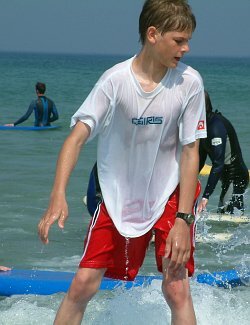
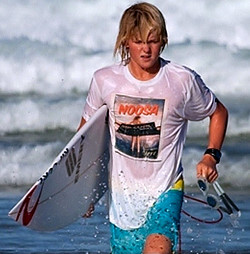
Robust surf shorts can withstand the power of big waves. Combined with a nice tee shirt you look cool around town, on the beach and in the water.
Sun Protection
In the 1980's rash guards appeared to protect your skin from the surf wax that keeps your surfboard from being slippery. Later they were found to be useful against sunburn. When people realised that sunburn can cause long term skin damage they covered up more and sun protection swimwear became fashionable, not only outdoors but in indoor pools too. Surf shirts became mainstream swimwear.
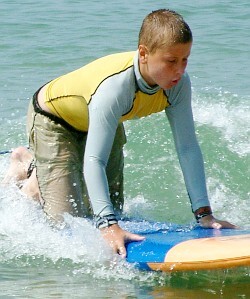
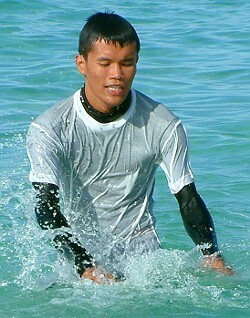
Surf Lifestyle
The laid back surfing lifestyle brought a wider choice of beachwear, like hoodies and beach pants made from quick drying materials. The swim clothes shown here are among the most comfortable outfits we could find. Kite pants are made the same way as shorts, just longer, same material. Loose fitting harem pants and surf hoodies dry quickly in the breeze.
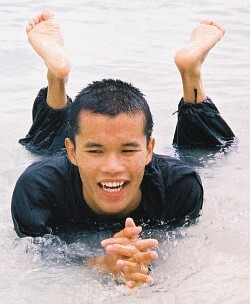
Nylon beach pants and a thin hoodie are very comfy swimwear.

As you wade into the water, you'll feel how soft they are.
Reader Story: Sun Sensitive Skin
by Rafael, Saintes Maries de la Mer, Provence, FranceMy skin is very sun sensitive, I get sunburned quickly in the warm sunny country were I live by the sea. Swimming and watersports are my passion but I have to cover up all the time, even in the water. This isn't easy.
Wetsuits are too warm except in Winter. It is such a performance to put on and off, also take a long time to dry. They are also not very breathable to be worn all day.
Spandex swimsuits and rash guards are great for swimming, but a bit delicate for rough and tumble sports. I'm also not to keen on wearing them all day long.
Sportswear and casual clothes are my usual swimwear, like joggers, jeans, tees, and hoodies. They feel great in the water, but take their time to dry.
So, I went to the local surf shop for advice. They said quick drying sportswear and leisure clothes would be best, like robust kite pants, sports shirts, anoraks and hoodies. Pants are to be worn without underwear to dry faster. One doesn't want to sit in wet undies for long.
They suggested I should try on a few of these clothes that were drying by their small pool. I changed into these clothes and went into the pool. Wow, they felt really good in the water and didn't slow me down much. They made me try a variety of outfits and I bought most of them.
In the morning I get dressed in these clothes and enjoy a swim in our pool. On the way to university they dry off completely. If I have time at uni I swim in their pool and then dry off before the next lesson. Many of my students have opted for similar clothes, so the can swim without the need to get changed.
After uni I go to the beach and swim with my friends.
Finally I take a long bath to rinse sweat and salt out and take care of nature's urges.
Amphibious clothes are the best.